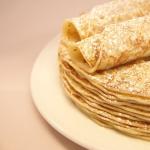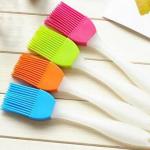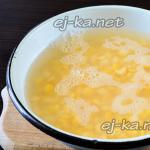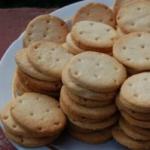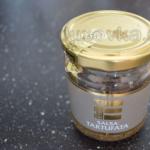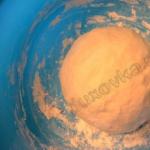How to grease puff pastry to make it golden brown. Puff pastry yeast frost - “puff pastry yeast dough. why do I prefer yeast to non-yeast!? step-by-step recipe for puff pastries with minced meat in photos. than to grease the pies. outwardly, almost like “denishes” made of a magnet.” Than sma
So, what can you grease pies with before or after baking, and what will come of it?
After all, the final result depends on what they are greased with: the pies become more ruddy and appetizing, with a soft matte or glossy and shiny crust.
There are different glazing options for each type of dough.
Egg
The most common and simple glazing of yeast and puff pastry is chicken egg. It is used whole or just the yolk. With the addition of milk, sour cream or water, as well as sugar. Baked goods brushed with yolk acquire the brightest and richest crust. For a more moderate color and gloss, the yolk is diluted with milk. If you want to get pies with a bright crust, but with less pronounced gloss, it is recommended to add sugar to the milk-yolk mixture.
Milk
Warm milk is also used as glazing, which is suitable for any type of baking. To do this, a few minutes before the pies are ready, use a brush to brush their surface with warm milk and place it back in the oven until golden brown. Sweet buns and pies will acquire an appetizing and moderately shiny crust if you brush them with sweetened milk.
After baking, rye flour pies are “bathed” in warm milk, this makes them soft.
Sweet tea
To give sweet pastries a golden brown crust without gloss, you can brush the pies with sweet, strong tea before baking. To do this, you need to dilute 2-3 tablespoons of sugar in 100 ml of hot tea leaves. Brush the cooled mixture onto buns or pies. You can use a tea bag as a “brush”. Some housewives dilute a small amount of flour (1 tablespoon) in a sweet brew and lubricate the products with this liquid glaze. As a result, the crust acquires a matte, bright color.
Plain water
To make the color of the crust appear a little and the crust to become softer, you can moisten the finished, still hot pies with plain water. The finished sweet pastries are brushed with sweetened water (or sweet soda). As a result, such buns and pies acquire a bright, glossy crust.
Vegetable and butter
To ensure that the baked goods have an unusually soft crust, the pies are greased with any vegetable oil, be it sunflower, olive or corn. However, you should not expect a shiny crust from this glaze. Vegetable oil can be greased with puff pastry or stretch pastry products before baking. Pies and flatbreads made from unleavened dough are brushed with melted butter immediately after baking. It is better to grease yeast or butter pies with butter when they are ready, but still hot.
Mixture of butter and yolk
For all types of pies and pies, butter glaze is suitable. It is prepared as follows: add the yolk to softened butter or margarine (1-2 tablespoons) and grind until smooth. Baked goods coated with this glaze before baking acquire a rather soft, bright and glossy crust.
Mixture of butter and flour
Before baking, any products can also be greased with a mixture of flour and butter. Mix softened butter with a small amount of water (cold), add a little flour and grind. Grease pies with this mixture before baking. For sweet pies and pies, you need to add sugar to the mixture.
Sour cream glaze
Before baking, grease sweet pies and buns very well with a mixture of sour cream, butter and flour, sprinkling sugar on top. To prepare this glaze, sour cream must be thoroughly mixed with flour and combined with cooled melted butter. Mix the mixture well again until smooth and homogeneous.
So, what can you grease pies with before or after baking, and what will come of it?
After all, the final result depends on what they are greased with: the pies become more ruddy and appetizing, with a soft matte or glossy and shiny crust.
There are different glazing options for each type of dough.
Egg
The most common and simple glazing of yeast and puff pastry is chicken egg. It is used whole or just the yolk. With the addition of milk, sour cream or water, as well as sugar. Baked goods brushed with yolk acquire the brightest and richest crust. For a more moderate color and gloss, the yolk is diluted with milk. If you want to get pies with a bright crust, but with less pronounced gloss, it is recommended to add sugar to the milk-yolk mixture.
Milk
Warm milk is also used as glazing, which is suitable for any type of baking. To do this, a few minutes before the pies are ready, use a brush to brush their surface with warm milk and place it back in the oven until golden brown. Sweet buns and pies will acquire an appetizing and moderately shiny crust if you brush them with sweetened milk.
After baking, rye flour pies are “bathed” in warm milk, this makes them soft.
Sweet tea
To give sweet pastries a golden brown crust without gloss, you can brush the pies with sweet, strong tea before baking. To do this, you need to dilute 2-3 tablespoons of sugar in 100 ml of hot tea leaves. Brush the cooled mixture onto buns or pies. You can use a tea bag as a “brush”. Some housewives dilute a small amount of flour (1 tablespoon) in a sweet brew and lubricate the products with this liquid glaze. As a result, the crust acquires a matte, bright color.
Plain water
To make the color of the crust appear a little and the crust to become softer, you can moisten the finished, still hot pies with plain water. The finished sweet pastries are brushed with sweetened water (or sweet soda). As a result, such buns and pies acquire a bright, glossy crust.
Vegetable and butter
To ensure that the baked goods have an unusually soft crust, the pies are greased with any vegetable oil, be it sunflower, olive or corn. However, you should not expect a shiny crust from this glaze. Vegetable oil can be greased with puff pastry or stretch pastry products before baking. Pies and flatbreads made from unleavened dough are brushed with melted butter immediately after baking. It is better to grease yeast or butter pies with butter when they are ready, but still hot.
Mixture of butter and yolk
For all types of pies and pies, butter glaze is suitable. It is prepared as follows: add the yolk to softened butter or margarine (1-2 tablespoons) and grind until smooth. Baked goods coated with this glaze before baking acquire a rather soft, bright and glossy crust.
Mixture of butter and flour
Before baking, any products can also be greased with a mixture of flour and butter. Mix softened butter with a small amount of water (cold), add a little flour and grind. Grease pies with this mixture before baking. For sweet pies and pies, you need to add sugar to the mixture.
Sour cream glaze
Before baking, grease sweet pies and buns very well with a mixture of sour cream, butter and flour, sprinkling sugar on top. To prepare this glaze, sour cream must be thoroughly mixed with flour and combined with cooled melted butter. Mix the mixture well again until smooth and homogeneous.
Both adults and children enjoy the fragrant and delicious homemade pie. In order for baking to be a success, you must not only follow a certain recipe, but also put a piece of your soul into the cooking process. The final touch that will give the culinary masterpiece a delightful appearance is the application of glaze. Knowing how to grease pies for a golden brown crust, the housewife will not only be able to make them more beautiful, but will also improve the taste of homemade baked goods. This article provides the best combinations of ingredients to ensure a beautiful and effective glaze. Every cook can choose the products that are right for him.
Water
What do you use to coat a pie for a crust that is soft and not too dark? Regular drinking water is suitable for this. It should be moistened or sprinkled on the finished but still hot baked goods. This is the easiest way to give the pie an appetizing look. This method can be used if there is no time or desire to prepare a mixture for greasing, if there are no necessary products in the house, or if the housewife simply forgot to treat the surface of the dough immediately before baking.
In order to get a smooth and shiny crust on the pie, which has a rich color, you should add a little sugar to the water. This mixture should be prepared based on the following proportion: one teaspoon of granulated sugar to one tablespoon of drinking water. You need to sprinkle the pie with this syrup twice: after proofing the dough and shortly before the end of cooking.
Chicken egg
What do you use to coat pies to get a golden brown crust? The most common and simple product for glazing is a chicken egg. In addition, this ingredient can be used regardless of the type of dough used.
Egg glazing requires care when working with it. After all, the mixture that gets on the baking sheet can stick the pies to it during the baking process.

The baking surface can be greased with either a whole chicken egg or a mixture of this product with water or milk. To achieve the effect of a light crust with a beautiful shine, you need to lightly beat the egg white and yolk with a fork and apply it to the dough before starting cooking.
If you use a mixture of egg and water, you will end up with a glossy surface of rich color. And when the white and yolk diluted with milk are used to grease the pies, the resulting golden brown crust will delight the hostess with its shine and softness. The proportion in both cases is the same: for one chicken egg - one teaspoon of liquid.
Egg white
Chicken eggs are not always used whole. Often, the white and yolk are used separately from each other to treat the surface of baked goods. Possible options for using these components are described below.

If you brush the pie with egg white, you will get a crispy, brittle crust. First, beat it a little with a fork. It is also possible to use a mixture of egg whites and a small amount of drinking water. In this case, the baking surface will be hard and shiny.
Egg yolk
What do you use to coat pies to get a golden brown crust? An egg yolk will do the job well. It is when using this product that the crust turns out to be the brightest and richest. The yolk is used both in pure form and in mixtures with milk or butter.
When using whole chicken yolk, you need to beat it a little with a fork and apply it to the surface of the dough just before baking. The crust in this case will have a golden color and unique brightness.

If the cake is brushed with yolk mixed with milk, the color of the baking surface will be less saturated and not so shiny. The crust will become soft. And if you add a little granulated sugar to such a mixture, the gloss will be removed, leaving only the richness of the color.
Another interesting glazing option is a mixture of one egg yolk and two tablespoons of softened butter. To prepare it, grind the indicated ingredients with a fork until smooth. Next, you need to apply the resulting mass to the surface of the pie at the end of the dough proofing process. The resulting crust will delight the hostess with its softness, golden color and beautiful shine. It is allowed to replace butter with margarine.
Vegetable oil or butter
How to grease pies before baking to make the crust extraordinarily soft? To do this, it is better to use oil, both butter and vegetable (sunflower, corn, olive, etc.). The surface of the pies will not shine, but the color will be bright.

When baked goods are prepared from puff pastries or it is recommended to use vegetable oil to lubricate the surface. A creamy product is more suitable for unleavened, yeast or butter pies. It should be melted and greased with the baking surface when it is ready, but has not yet cooled down. In addition, butter gives pies a unique aroma.
Strong tea
And a bright shade of crust without gloss? In this case, it is perfect for surface treatment. You can use either an unsweetened infusion or with the addition of a small amount of sugar. In the second case, the color of the crust will be more intense. To do this, dissolve approximately 2-3 tablespoons of sugar in 100 milliliters of liquid. The resulting solution must be lubricated with the surface of the dough twice: immediately before baking and a few minutes before the pie is completely ready.

You can also add color saturation using flour. To do this, you need to add a tablespoon of the specified product to the prepared sweet tea infusion, mix well and grease the surface of the pie with the resulting mass at the end of the dough proofing process.
Milk
How to grease a pie if there is no egg? Regular milk also works well for glazing. This product will be suitable for any baking, regardless of the type of dough used. The milk must be heated. They should be brushed onto the surface of the pie a few minutes before the baked goods are ready.

When using this product for glazing, the crust of the finished culinary product will have an appetizing shine. If so, it is recommended to add a little sugar to the milk. In this case, the surface of the cake will not be as glossy, but the color will become more saturated.
Butter with flour
Another interesting glazing option could be a mixture consisting of butter and flour. You need to prepare it as follows. It is recommended to mix melted butter with a small amount of cold drinking water. After that you need to add a little flour and grind well until a homogeneous mass is obtained. This glazing is suitable for any dough.

If the cake is sweet, it is recommended to add a small amount of sugar to the resulting mixture. This will give the crust a golden hue. The baking surface should be treated with this glaze immediately before cooking. It is allowed to replace butter with margarine.
Sour cream
You can use sour cream as a glaze. For pies with unsweetened filling, mayonnaise may be used. These products are applied to the surface of the dough immediately before baking. It is important that the layer of sour cream or mayonnaise glaze is very thin.

A mixture prepared as follows is well suited for treating the surface of sweet pies. You need to add a little flour to the sour cream and mix well. Then add melted butter and bring until smooth. This glaze should be applied to the surface of the dough after proofing is complete. Sprinkle the top of the pie with a small amount of granulated sugar.
Conclusion
To give homemade baked goods an even more appetizing appearance, you need to use glazing. What do you use to coat pies to get a golden brown crust? To do this, use water, a chicken egg, butter or vegetable oil, tea leaves, sour cream or milk in various combinations. The external one will vary depending on the chosen glaze. You need to grease the baking surface with gentle, light movements. The ideal device for this is a special silicone brush. It is soft, easy to use and does not crush the dough at all.
Many people love airy and crispy puff pastry - pies made from it are especially tender, light, melting in the mouth. And baked goods from such dough, prepared with your own hands, are even tastier than semi-finished products from the store. Although this type of dough is considered “capricious,” it is not difficult to prepare if you know some culinary secrets.
Peculiarities
 Puff pastry is much more nutritious than regular yeast or unleavened dough, since it contains a large amount of oil. And it is impossible to do without fat, thus making the dough and products made from it more suitable for those who are on a diet: it is thanks to oil that the dough becomes airy and light, and acquires a unique layered structure.
Puff pastry is much more nutritious than regular yeast or unleavened dough, since it contains a large amount of oil. And it is impossible to do without fat, thus making the dough and products made from it more suitable for those who are on a diet: it is thanks to oil that the dough becomes airy and light, and acquires a unique layered structure.
Puff pastry can be either yeasted or yeast-free (unleavened). Unleavened dough rises due to the fact that the oil evaporates during baking and thus separates the layers from each other. After this, the oil is absorbed into the layers, preventing them from sticking together again. Yeast dough also becomes flaky thanks to the layers of butter. Yeast additionally loosens the dough, making it softer, airier and lighter. It is believed that yeast dough is suitable for absolutely any baking, and from unleavened dough it is better to make small-sized products, mainly with sweet fillings.
You need few ingredients to make puff pastry: you will need flour, water, fat and only in some cases yeast. But preparing such a dough takes a lot of time. If you follow classic recipes, the layer of yeast-free dough should consist of almost three hundred layers. If yeast dough is used, the number of layers usually varies from twenty-four to ninety-six. There are, however, recipes for the so-called “early ripening” puff pastry, which cooks much faster, but is also somewhat inferior in taste to the classic one.
Secret one: ingredients
 Flour for making puff pastry must be chosen especially carefully. It is not enough to buy premium flour, you also need to pay attention to the gluten content in it: the higher it is, the easier it will be to prepare puff pastry, and the tastier it will be. The flour must be sifted before use.
Flour for making puff pastry must be chosen especially carefully. It is not enough to buy premium flour, you also need to pay attention to the gluten content in it: the higher it is, the easier it will be to prepare puff pastry, and the tastier it will be. The flour must be sifted before use.
The water for the test should be cold, but not ice-cold. Some people prepare puff pastry using a mixture of water or milk or only milk. The taste improves, but the dough becomes less elastic.
Salt should be added exactly as specified in the recipe, no more (the taste will deteriorate) and no less (the layers will “float”). You can use regular table or sea salt - it will not affect the taste. You can also add a little citric acid or a few drops of vinegar to the dough - this will make the dough more elastic. But acids should be used very sparingly so that they do not spoil the taste.
Puff pastry can be prepared with butter or creamy margarine. The first option is preferable - with real butter the dough turns out more tasty. At the same time, special margarines with a high melting point make it possible to obtain a particularly fluffy dough. You should not take the so-called “light” versions of butter or margarine - products with them will not be fluffy enough. Fats should be thoroughly cooled, but not frozen, to prevent the layers of dough from tearing.
Sometimes whole eggs or just yolks are added to puff pastry - this makes the dough tastier. Another popular addition to unleavened puff pastry is a small amount of cognac or other strong alcohol.
Secret two: rolling out
Flour, liquid, salt and acid are thoroughly mixed. Yeast, if called for in the recipe, is added to the dough last. The kneaded dough should be allowed to rest for half an hour, covered with a clean napkin. While the dough is resting, you need to make a rectangular cake from a mixture of butter and a small amount of flour and leave it in a cool place. After this, you can start rolling out the layers.
The quality of rolling out the dough determines its structure and taste.
It is very important to roll it out in one direction, pressing evenly on the rolling pin. Place a butter cake in the center of the layer, then pinch the ends of the dough layer with an envelope. This envelope must be carefully rolled out in one direction, folded into four and left for twenty minutes in a cool place. This operation is repeated several more times, after which you can begin cutting the dough.
Secret three: cutting and baking
 You should cut the dough only with a very sharp knife that will not crush the layers. Puff pastry is very flexible; it can be used to form different figures - from simple croissants and “bows” to complex “flowers” and “medallions”.
You should cut the dough only with a very sharp knife that will not crush the layers. Puff pastry is very flexible; it can be used to form different figures - from simple croissants and “bows” to complex “flowers” and “medallions”.
Before baking, the top of the products can be brushed with beaten yolk for extra shine. It is not recommended to brush the edges of the dough with yolk to prevent them from becoming too hard. If you are baking a more or less large puff pastry pie, then it is advisable to pierce it in several places with a fork: then the dough will not bubble and the pie will retain its beautiful shape.
The product is baked on an ungreased baking sheet covered with baking paper. It is advisable to cool the baking sheet before baking, for example, rinse it with cold water. Future puff pastries are laid out on a cool surface, after which they can be sent to the oven, heated to two hundred twenty or two hundred forty degrees. At lower temperatures, the fat may melt and the pies  will turn out to be insufficiently layered and airy. And if the temperature is too high, the products will quickly harden on the outside, remaining half-baked on the inside.
will turn out to be insufficiently layered and airy. And if the temperature is too high, the products will quickly harden on the outside, remaining half-baked on the inside.
Yeast dough puffs  Just before baking, you need to stand a little (literally a few minutes) in a warm place so that the yeast fungi wake up and begin their work. But if the puff pastries are kept warm for too long, there is a risk that the butter will melt too quickly and leak out of the products.
Just before baking, you need to stand a little (literally a few minutes) in a warm place so that the yeast fungi wake up and begin their work. But if the puff pastries are kept warm for too long, there is a risk that the butter will melt too quickly and leak out of the products.
Maria Bykova
Whether you like it or not, you have to cook 😂 Well, but seriously, sometimes you just want to pamper your loved one. Yes Yes Sometimes , so that my love will not be deposited on his sides.
But I’m not on top level with all types of tests. But I’m friends with store-bought puff pastry.
In this review we will test puff pastry dough "Morozko". Why I prefer yeast to non-yeast, it’s simple - baked goods from the former do not crumble.
This dough is affordable: 60-90 rubles, which can be bought in convenience stores.
And so we move from blah blah to the kitchen:
Frozen defrost the dough for 1.5 hours at room temperature.
What man doesn't love meat , so we make the filling: fry minced meat with onions , salt and pepper immediately.

To make our racks look beautiful, we prepare lubricant - take an egg and separate the white from the yolk in different containers. Next you will see the difference!


Open the package and cut the dough:



Push the dough a little from the center to the edges:

We go over the piece with a fork:

Spread the cooled filling on half, leaving the dough around the edges for clamping:

Cover with the other half and press the edges with your fingers, then go over them with a fork for beauty:


Using a sharp knife, make notches in the dough so that excess steam escapes and the puff pastries come out of the oven beautifully:

While the puff pastries are rising on a greased baking sheet, preheat the oven to 200 degrees:

Lubricate some of the puffs with a little egg white, others with yolk:

That's it... put it in the oven at 180 degrees for about 15 minutes. Do not open the oven while baking, just watch through the window!
After a couple of minutes they have already increased in volume:

After 10 minutes:

15 minutes have passed. It's time to get:

Well, here’s how we see the difference in the grease: those greased with yolk are more rosy and the crust is crispier, while those greased with egg white are lighter and have a more delicate-tasting top. Everything is for everyone...

Experiment! My husband was left full and satisfied!
Let's summarize... I liked the dough:
✔ delicious
✔ when turning the roll, the dough does not break
✔ the manufacturer did not spare film when wrapping the dough


✔ saving time and sometimes nerves
✔ for the lazy
✔also for busy people
There were some downsides:
✔ not an ideal composition. Do you want perfect!? Do it yourself 😂

